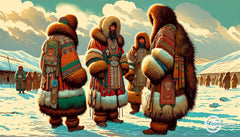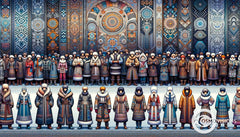Exploring The Ancient Beliefs And Practices Of Yakut Shamanism
Posted by Massimiliano Geraci

The mysteries of ancient spiritual practices have always drawn the curious and those seeking deeper understanding of our world's rich cultural tapestry. Perhaps you've felt an inexplicable pull towards the elemental forces of nature or yearned to uncover the hidden workings of ancestral wisdom deeply rooted in remote corners of our planet.
One such wellspring of mystic knowledge is Yakut Shamanism, practiced by the Sakha people, whose customs have rippled through time despite history's many upheavals.
Discover how the intricate beliefs and rituals from Siberia's frozen heartlands can offer insights into a way of life that honors unseen worlds and sacred connections. This captivating article will take you on a journey through the fascinating universe of Yakut shamans, revealing their initiation rites, struggles for preservation against odds, and enduring legacies.
Unravel this immersive tale to enrich your understanding—and perhaps find a new appreciation—for traditions that dance with spirits beneath vast Siberian skies. Stay tuned to explore what has been carefully guarded for centuries: secrets now whispered beyond the veil.
The Ancient Beliefs and Practices of Yakut Shamanism
Dive deep into the mystical realm of Yakut Shamanism, where ancient traditions and spiritual practices form the backbone of Sakha culture. Discover how this rich tapestry weaves together the lives and beliefs of a people intrinsically connected to nature's rhythmic cycles and mysterious powers.
Sakha people and their traditional shamanic practices
The Sakha people honor a timeless tradition of shamanism that breathes life into their culture and spiritual practices. In the heart of Siberia, they practice a form of spirituality that recognizes three different worlds: the upper, middle, and lower realms.
Their shamans serve as intermediaries between these realms and the community, performing ceremonies meant to maintain harmony with nature and the cosmos. Using drums, dancing, and singing, shamans enter trances to communicate with spirits and guide souls.
These ancient rituals are passed down through families because it is believed that shamanic abilities are inherited from ancestors.
Shamans hold great respect within Sakha society for their roles as healers, storytellers, and keepers of wisdom. Their influence stretches beyond religion into every aspect of life—from hunting expeditions to wedding feasts—underscoring their integral role in preserving Sakha heritage.
As we explore further into Yakut shamanism's profound connection to nature and spirit world communication techniques such as trance work continue revealing how deeply this tradition is woven into the fabric of Sakha identity.
The Sakha religious system and the role of shamans
Shamans stand at the core of the Sakha religious system, serving as crucial bridges between humans and the myriad spiritual entities that inhabit upper, middle, and lower realms. Their unique role empowers them to channel communications and conduct intricate ceremonies which ensure harmony within their communities.
With skills thought to be passed down through ancestral lines or sometimes emerging in those without shamanic lineage, shamans engage in practices such as monotonous drum beating, dance sequences, and recitals to navigate other realities.
Equipped with knowledge passed through generations, these healers wield instruments and embrace traditional techniques that echo across Siberian landscapes. Their rituals are believed to safeguard not only individual well-being but also maintain cosmic balance by appeasing supernatural forces.
Transitioning into our next topic of discussion requires an understanding of how one embraces such a profound vocation—the initiation process—a journey filled with ritualistic preparation and transformational experiences that shape the essence of Yakut shamans.

The Initiation Process of Yakut Shamans
Embarking on the path of a Yakut shaman is akin to traversing the mysterious layers of the human soul, where an intricate initiation process not only serves as a rite of passage but also seals one's destiny as an intermediary between the earthly realm and spiritual worlds.
This transformative journey demands both physical endurance and psychic awakening, marking the birth of a figure central to maintaining harmony within their community.
The preparation and ritualistic journey to becoming a shaman
Before a Yakut individual steps into the revered role of a shaman, they must first navigate a profound spiritual metamorphosis. This transformative period is marked by intense experiences that are said to mirror mental illness, where the candidate endures extreme psychological and emotional trials.
These tribulations are not aimless; they serve as the foundational groundwork for developing the heightened sensitivities required for communicating with supernatural powers.
The initiation ceremony that follows this preparation is nothing short of dramatic, symbolizing death and rebirth in its most literal sense. The future shaman's body is ritually dissected and then pieced back together—a chilling enactment manifesting their own resurrection into shamanhood.
Adhering to a sacred lunar calendar, this pinnacle event spans three days of symbolic demise and mystical revival, all performed under strict traditional laws with sharp implements at hand.
It’s during these climactic moments that prayers ascend, and the would-be shaman transcends their former earthly constraints—emerging anew with abilities poised to serve their community within the tapestry of Sakha beliefs.
The impact of the initiation on the future shaman's role in the community
The initiation erects a pivotal bridge in the life of a Yakut shaman, marking their passage from mere mortals to revered spiritual healers. These transformative rituals bestow upon them distinct qualities and responsibilities, deeply rooting their influence within the community's fabric.
As they emerge reborn from this rite of disintegration, shamans gain not only healing abilities but also become intermediaries between their people and the spirit world. They wear these diverse roles with honor—guides, counselors, and protectors against supernatural beings—and wield immense respect amongst the Sakha.
With each prohibition navigated and each rule absorbed during this intense period of transformation, future shamans align closer with their role as cultural cornerstones. The symbolic death they undergo signifies more than personal change; it is an indispensable renewal that mirrors their duty to maintain cosmic balance among living beings.
Their illness becomes a testament to resilience—a beacon leading them on a journey filled with psychic challenges that cultivate wisdom necessary for guiding others.
Their new identity integrates seamlessly into daily life as they stride forward confidently bearing fresh purpose: safeguarding traditions like olonkho storytelling while binding together human experiences with those of elder gods and spirits across Siberia's expanse.
The next chapter in our exploration delves into historical impacts that tested Yakut Shamanism's fortitude through time.
Historical Impact on Yakut Shamanism
The tumultuous history of the Sakha Republic has left indelible marks on the fabric of Yakut shamanism, with external forces challenging its existence while paradoxically reinforcing the resilience and adaptability of this ancient spiritual tradition.
From religious oppression under Tsarist Russian rule to ideological suppression during Soviet times, Yakut Shamanistic practices have been tested by political upheavals yet continue to thrive as a testament to cultural endurance and identity among the Sakha people.
The influence of the Orthodox Church and the Bolshevik revolution
Years of effort from the Orthodox Church aimed to wipe out pagan customs among Sakha communities, introducing Christianity as a means to unify under one faith. Priests and missionaries sought to baptize the Yakut people, pushing for them to trade old deities for new saints and adopt Christian practices over ancient shamanistic rituals.
This cultural collision left deep imprints on Yakut spirituality, birthing a hybrid of beliefs that wove together elements from both worlds.
With the 1917 Bolshevik revolution came fresh waves of disruption across Siberia's landscape. Revolutionary fervor swept through peoples like the Sakha, challenging shamans who stood firm against these drastic societal changes.
The Soviet regime enforced state atheism and stripped away shamanic power by seizing sacred items and punishing those who resisted their ideology. Despite these aggressive measures, Yakut folklore endured, absorbing revolutionary themes into its narrative tapestry while maintaining core shamanistic principles beneath an ever-evolving exterior.
Attempts to suppress traditional beliefs and the resilience of the Sakha people
Throughout the nineteenth and seventeenth centuries, forces within the Russian Federation worked tirelessly to dismantle the ancient shamanic practices of the Sakha. The Orthodox Church led this charge with fervor, aiming to replace indigenous ceremonies with Christian rituals.
Similarly, during the era of the Soviet Union, republican authorities clashed with shamans. These spiritual leaders were seen as threats to progress and often found themselves stripped of their sacred items and facing persecution.
Despite these heavy-handed tactics, the spirit of Yakut shamanism proved unyielding. In response to attempts at suppression, these resilient people held fast to their beliefs. Across Siberian landscapes and especially within areas like Sakha (Yakutia), a silent yet profound defiance took root.
This resurgence saw traditional cultural forms being rekindled in recent times—a testament not only to endurance but also an undying respect for ancestral wisdom that has breathed new life into rituals once thought lost behind political veils cast by Moscow's reach.
Theirs is a story of tenacity; amidst challenges, fermented mare's milk continues to be poured as libations while souls commune through age-old rites under North’s celestial dome.

The enduring significance of Yakut Shamanism and the preservation of traditional culture
Yakut Shamanism stands as a beacon of cultural resilience, shining brightly through the annals of time. This spiritual practice preserves a unique connection between the Sakha people and their ancestors, maintaining an unbroken thread to early Siberian beliefs.
Amidst rapidly changing modern landscapes, the rituals and ceremonies performed by Yakut shamans continue to foster a deep sense of identity and community among its followers. Even with historical pressures from external religious forces like the Orthodox Church, which aimed to replace native customs with Christian ones, shamanism's core values and practices have remarkably survived.
The revival of interest in traditional healers demonstrates how indigenous wisdom is not only surviving but also thriving in contemporary society. By embracing aspects such as feasting traditions connected with ancient festivals or seeking guidance through shaman-led journeys across cosmic realms, individuals are actively engaging with their cultural heritage.
These practices are not relics of the past; they serve as living testimony to endurance amidst adversity for small peoples like the Sakha—guarding their animist roots against waves of political and religious change that once threatened to sweep them away completely.














